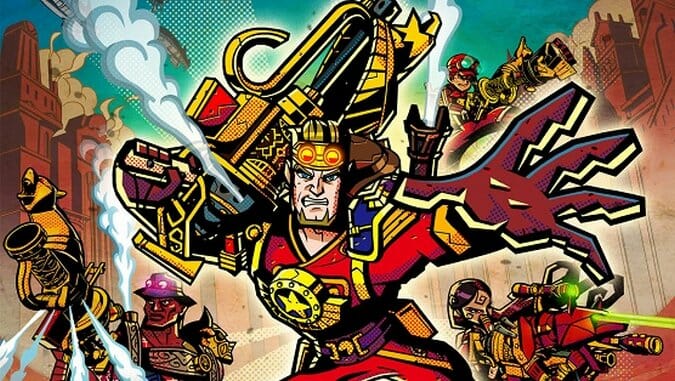Code Name: S.T.E.A.M.: Jack Kirby’s Adventure

Here’s the second game in a month indebted to steampunk, an aesthetic that felt overexposed and exhausted a decade ago. Unlike The Order: 1886, Code Name: S.T.E.A.M. at least has fun with the idea, contextualizing itself as a comic book story within the world of the game—perhaps in a nod to Grant Morrison, the game directly acknowledges you as the player/reader, as it starts with you picking up a comic book before zooming into a panel for the opening cut-scene. It’s set up as an American League of Extraordinary Gentlemen, with figures from history, literature and folklore teaming up to fight off an alien invasion, including Abraham Lincoln, John Henry and the guy from The Red Badge of Courage. Cut-scenes scan from panel to panel, and the character designs resemble Jack Kirby artwork, blocky characters with elaborately armored costumes in foreshortened poses. Even if your tolerance for steampunk is depleted, S.T.E.A.M.’s light-hearted nature might float your zeppelin.
As nice as that art style is (and sadly it looks a little fuzzy and rough around the edges on the 3DS, especially when the 3D effect is turned on), it’s the game itself that’s earned S.T.E.A.M. advance interest and that should make it a cult favorite among fans of a certain genre. S.T.E.A.M. is a turn-based strategy game, and it’s made by one of the top developers in that field, Intelligent Systems. That’s Nintendo’s go-to studio for strategy games, the designers behind Fire Emblem and Advance Wars, and with Code Name: S.T.E.A.M. they’ve created another game that should have a long, many-sequeled life on Nintendo systems.
Beyond the steampunk biz, what sets S.T.E.A.M. apart from Fire Emblem and Advance Wars is its point of view. Instead of looking at your units from the top down, like pieces on a map, you see everything from a third person perspective. Other than a quick sweep of the map at the start of every mission, you only see what your units see, scoping out the battlefield from their line of sight and locating enemies when they do. You have to aim at your enemy with your steam-powered rifles and muskets when you attack, and you can do more damage if you target their weak spot. This makes it feel more like Sega’s fantastic Valkyria Chronicles games than a reformulated Fire Emblem, filling a niche that’s always remained empty in Nintendo’s line-up of strategy games.

If you think you’re new to turn-based strategy games, well, you probably aren’t. Imagine chess or Risk. You and your variety of units wage war against another player one turn at a time. In the primary campaign mode that other player is the computer, who has a massive army of aliens at its command. You can take up to four units into each battle, and every turn you directly guide each unit through its possible motions. Your units are limited by the amount of steam in their boilers, which power every action they take, from moving to attacking. These actions all use up a bit of steam, and when the boiler is empty that unit’s turn is over. That’s where the strategy comes in—you have to maximize the usefulness of every unit during every turn despite a limited pool of steam, all while outmaneuvering your opponent.
When it comes to options S.T.E.A.M. is lighter than top console strategy games like Final Fantasy Tactics, Valkyria Chronicles and Fire Emblem, which are already streamlined compared to such sprawling PC military simulators as Total War. The four unit cap is small for the genre—most games of this style let you take larger armies to war, with troop sizes often fluctuating based on the specifics of each mission—and this limits the tactics you can put into play. It takes a while for S.T.E.A.M. to even open up that fourth slot, or to have enough units to turn roster selection into a strategic decision. There are no defined classes, with units varying based on their primary weapons and once-a-mission special abilities. You unlock new boilers and weapons by collecting gears strewn across each mission, three per map, and these new items can increase a unit’s attack power or define the amount of steam they’ll have at the start of each turn. Unlike most strategy games, where weapons and armor can only be used by specific classes or characters, these units don’t seem to be restricted from equipping any secondary weapons or boilers.